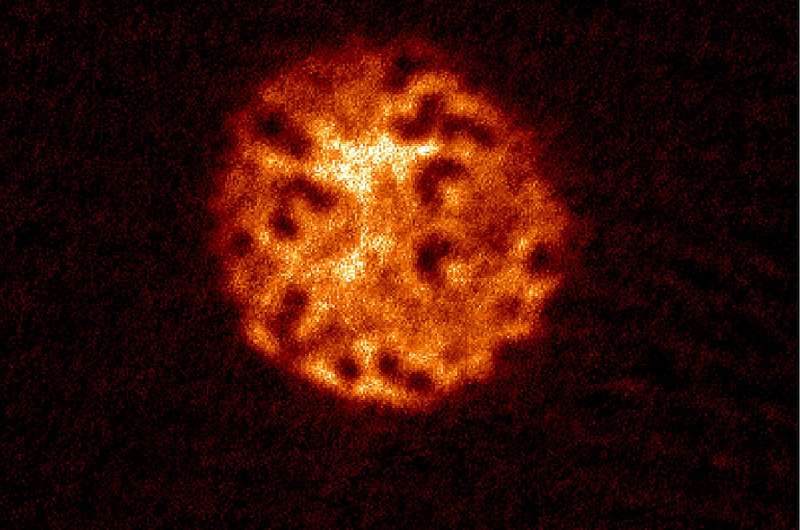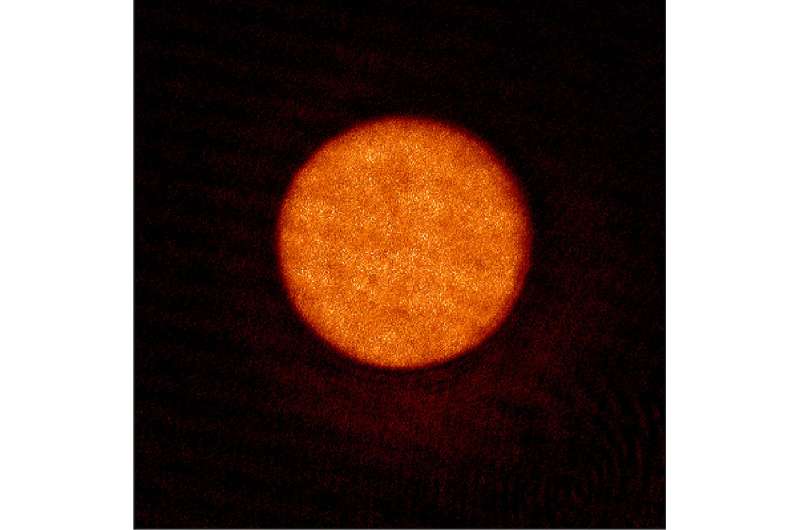August 20, 2024 feature
This article has been reviewed according to Science X's editorial process and policies. Editors have highlighted the following attributes while ensuring the content's credibility:
fact-checked
peer-reviewed publication
trusted source
proofread
Physicists successfully observe Kibble–Zurek scaling in an atomic Fermi superfluid

The Kibble–Zurek (KZ) mechanism is a theoretical framework introduced by physicists Tom Kibble and Wojciech Zurek. This framework essentially describes the formation of topological defects while systems undergo non-equilibrium phase transitions.
Researchers at Seoul National University and the Institute for Basic Science in Korea recently observed KZ scaling in a homogeneous and strongly interacting Fermi gas as it was transitioning into a superfluid.
Their paper, published in Nature Physics, could pave the way for further experimental efforts probing this long-standing physics framework.
"Superfluidity and superconductivity have fascinated physicists for nearly a century," Kyuhwan Lee, co-author of the paper, told Phys.org. "They are beautiful manifestations of quantum mechanics on a large scale.
"Loosely speaking, when we have many interacting particles that are cold enough, they can collectively flow without any resistance. A natural question that follows is, how are superfluids born and what happens during the transition from a normal phase (in which they flow with resistance like most ordinary liquids) to a superfluid phase?"
In the 1980s, Zurek set out to tackle this interesting research question experimentally, drawing inspiration from Kibble's recent cosmological frameworks. Zurek proposed that probing the remnants of a physical system's phase transition into a superfluid would gather interesting insight about how superfluids originate.
"In the context of our experiment, the remnants are quantum vortices, a swirly flow with a quantized angular momentum," Lee said. "The central prediction, now also known as the KZ scaling, is that the number of quantum vortices should scale as a power-law with respect to how fast you pass through the superfluid phase transition.
"The faster you go across the phase transition, the more quantum vortices you end up with due to less time the superfluid needs to adjust to the external changes of the system parameters."
While KZ scaling is applicable to a wide range of systems, including superfluids, ferroelectrics, superconductors, ion traps and Rydberg atom arrays, so far it has primarily been observed in some of these systems. The main objective of the study by Lee and his colleagues was to observe KZ scaling in a Fermi superfluid, which has so far proved particularly challenging.
"The real kick here is that we observed the predicted KZ scaling behavior using both temperature and interaction strength as two distinct control knobs," Lee said.

The sample used by the researchers was an atomic cloud of 6Li, which were cooled down to extremely low temperatures (i.e., a few tens of nano Kelvin). Their sample had a unique configuration, which they created using a spatial light modulator (SLM). Its configuration consisted of a spatially uniform atomic cloud with a disk geometry and a diameter of roughly 350 um.
"To observe the KZ scaling behavior, we needed a spatially uniform sample with a large area," Lee explained. "It had to be uniform because we wanted the superfluid phase transition to occur simultaneously throughout the entire sample.
"If there are irregularities, phase transitions occur at different times for different locations, which make the observations hard to compare to theoretical predictions. We also wanted it large, so that we could observe a lot of quantum vortices and avoid finite-size effects."
A further important factor that the researchers considered when designing their experiment was the tunability of interactions in their experimental system. To tune interatomic interactions, they leveraged the so-called magnetic Feshbach resonance between 6Li atoms in their cloud.
"This equipped us with another tool to investigate the superfluid phase transition dynamics, instead of only using temperature as a control knob," Lee said. "Armed with these exciting tools, we quenched either the temperature or the interaction strength across the superfluid phase transition with varying speed."
Irrespective of whether they changed the temperature of their system or the strength of interactions between atoms, Lee and his colleagues observed an identical (i.e., universal) KZ scaling behavior in their sample across a wide dynamic range. Their study thus yielded the successful observation of KZ scaling in a superfluid, which previously remained elusive.
"In liquid 4He, another representative example of a superfluid system, the typical timescale of the phase transition dynamics was simply out of reach with conventional mechanical pressure quenches," Lee said.
"In liquid 3He, there were signatures of quantum vortex generation, which was enabled by fast nuclear reactions. Many unknown factors, however, made a direct comparison with the KZ scaling difficult.
"In ultracold atomic gases, there is important work on verifying the spontaneous generation of quantum vortices and unveiling the static and dynamic scaling properties, but the typical sample configuration made it difficult to capture the KZ scaling behavior."
The recent work by this team of researchers is a significant contribution to the study of KZ scaling in superfluids. Its most notable achievement was the observation of identical scaling behavior irrespective of whether the team was manipulating the temperature or interactions in their sample.
"The concept of universality, which nowadays is even taught in undergraduate Statistical Mechanics courses, allows us to understand mind-boggling complex systems in a very 'economical' way," Lee said. "It is truly stunning that we can sort out a common feature in such complex phase transition dynamics."
In their next studies, Lee and his colleagues plan to further investigate the behavior they observed during their experiments that may not be simply explained by the KZ mechanism. Their future efforts could lead to further valuable observations, further enhancing the understanding of non-equilibrium phase transition dynamics in Fermi superfluids.
"For rapid quenches, we observed a deviation from the KZ scaling behavior for both temperature and interaction quenches," Lee explained. "One possible scenario for explaining this is the so-called early-time coarsening.
"Simply put, early-time coarsening suggests that the initial (or early) superfluid growth dynamics suppresses the formation of quantum vortices for rapid quenches. Using interferometry methods for measuring phase coherence, it would now be interesting to investigate how coarsening dynamics fit into the picture."
More information: Kyuhwan Lee et al, Universal Kibble–Zurek scaling in an atomic Fermi superfluid, Nature Physics (2024). DOI: 10.1038/s41567-024-02592-z
Journal information: Nature Physics
© 2024 Science X Network





















